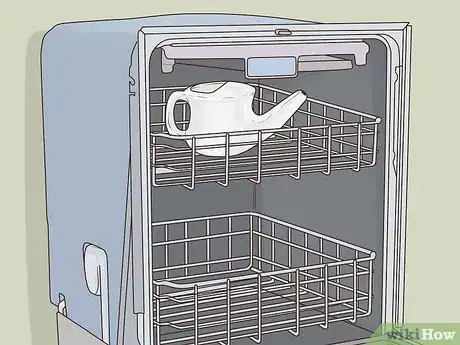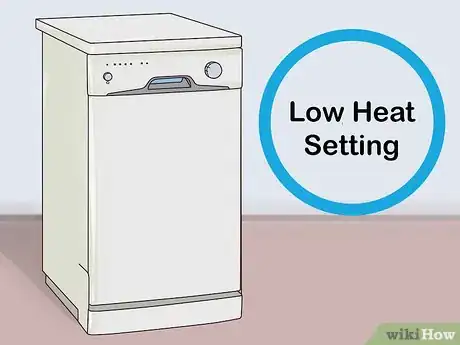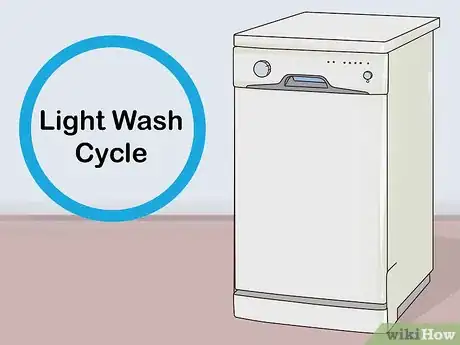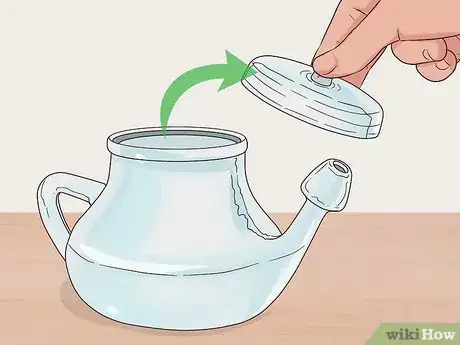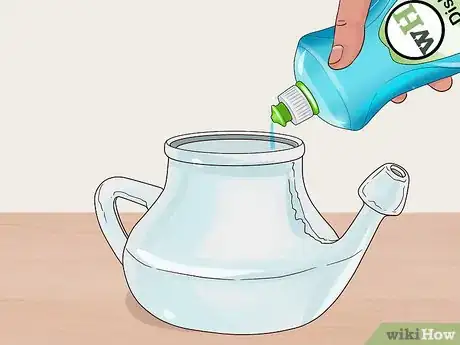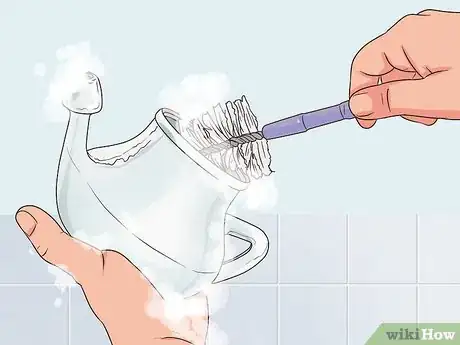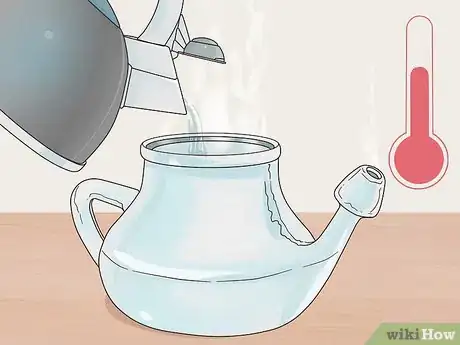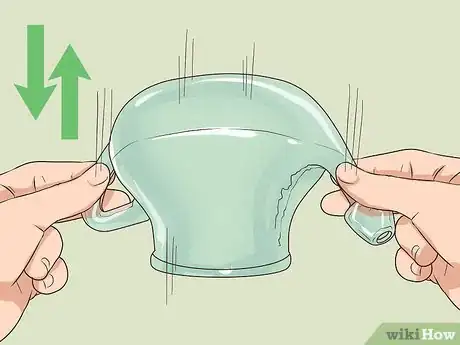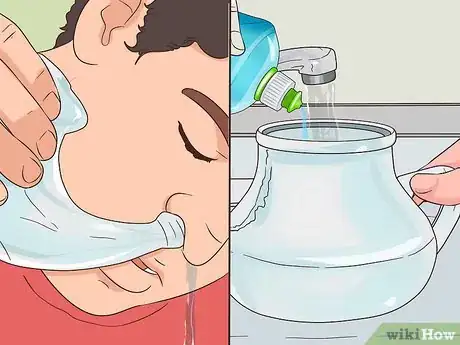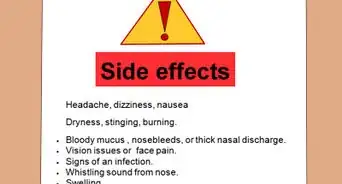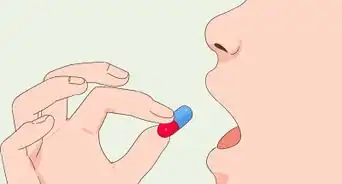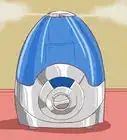This article was co-authored by wikiHow Staff. Our trained team of editors and researchers validate articles for accuracy and comprehensiveness. wikiHow's Content Management Team carefully monitors the work from our editorial staff to ensure that each article is backed by trusted research and meets our high quality standards.
There are 10 references cited in this article, which can be found at the bottom of the page.
This article has been viewed 78,798 times.
Learn more...
Neti pots are useful little tools for clearing out stuffy, congested sinuses. If used incorrectly, however, they can cause irritation or even infection. In order to ensure proper hygiene and safety, it's important to know the best way to sterilize your neti pot after use. Fortunately, their smooth material and basic construction makes them a snap to clean. Most neti pots can simply be run through the dishwasher, or you can wash them by hand using a mild dish soap and warm water if you're worried about damaging your device.
Steps
Putting a Neti Pot Through the Dishwasher
-
1Place the neti pot in the dishwasher on the top rack. Situate the pot upside down so that water will be able to flow through it during the wash cycle. Keeping the neti pot at a distance from the force washing action will prevent it from becoming damaged. On the uppermost rack, the device will receive a more gentle cleaning.[1]
- Protecting your neti pot from damage is especially important if it's constructed of a breakable material like ceramic or features a lot of small, delicate pieces.[2]
- Set the lid, along with any other removable parts, on the rack next to the pot.
-
2Set the dishwasher to a low heat setting. If your dishwasher allows you to change the temperature settings, set it as low as it will go. Intense heat can melt or warp neti pots made of plastic. This is another reason why it's a good idea to make room for the device on the top rack where it won't be exposed to the hot water as constantly or directly.
- Be sure to check the manufacturer's cleaning recommendations included with your device before putting it through the dishwasher.[3]
Advertisement -
3Run a light wash cycle. It won't take long for the dishwasher to successfully sanitize your neti pot, so the shortest wash time will suffice. Once it's complete, carefully remove the device and set it aside on a clean towel or dish rack. Allow the neti pot to finish cooling and drying before resuming use.[4]
- The dishwasher will also take care of the drying process, saving you time compared to air drying.
- Ceramic and metal neti pots will be extremely hot when they first come out of the dishwasher, so handle them with caution.
Cleaning a Neti Pot by Hand
-
1Remove the lid. Take the lid off of the pot and rinse the underside with hot water. Set the lid aside on a clean towel. You'll be cleaning this along with the rest of the pot.
- Don't neglect the clean the lid of the pot. Though it doesn't come into direct contact with your nose, it's possible for bacteria to infiltrate the pot as used solution is pulled back into it.
-
2Rinse out the inside of the pot. Run a stream of hot water directly into the pot. Swirl the water around to make sure you hit the entirety of the interior. When you empty the water, pour it out through the spout. This will help flush out bacteria and traces of used irrigation solution.[5]
- A preliminary rinse will wash away most unwanted contaminants and should be performed immediately following ordinary usage.
-
3Add a few drops of soap. It's recommended that you use a mild cleanser, like liquid dish detergent or antibacterial all-purpose soap. Squeeze the soap into the bottom of the pot, then fill it up about three quarters of the way full with hot water. For best results, leave the soap solution to soak for a few minutes before scrubbing.[6]
- Never use soaps containing harsh chemicals or astringent agents. Besides being hazardous to put in your body, these compounds are capable of causing structural damage to the device itself.
-
4Scrub the pot with a bottle brush. Take a clean (or recently sterilized) bottle brush and insert it through the opening in the top of the pot to clean the interior. Gently scour the pot inside and out, covering as much surface area as you can. Scrubbing the pot will loosen unseen bacteria and possible buildup from the irrigation solution, while the soapy water cleans and disinfects.[7]
- Rotate the neti pot as you scrub to make hard-to-reach spots more accessible.
- Don't forget to go over the inside of the lid with the brush while you're at it.
-
5Rinse the pot again using boiled or distilled water. Flush out the spout and the area around the lid thoroughly. Refill and empty the pot repeatedly until the water is completely clear. There should be no soap solution remaining when you're finished.[8]
- Tap water may contain chemicals and other contaminants that can be potentially harmful if introduced to your sinuses.[9]
- When inadequately rinsed, the soap can form a thin film over the inside of your neti pot, causing irritation to your sinuses.
-
6Allow the pot to air dry. After rinsing, shake the excess water from the pot and position it upside down so that it can finish draining as it dries. And, of course, leave the lid off to prevent moisture from becoming trapped inside. When your neti pot is fully dry, it can be refilled and returned to action.[10]
- If moisture becomes trapped in your neti pot, it can lead to the growth of mold and bacteria.
- You can also dab the outside of your neti pot dry using a clean microfiber towel. Avoid towels made from cotton or similar fabrics—these can leave behind small fibers that will then end up in your irrigation solution.[11]
Using Your Neti Pot Safely and Correctly
-
1Wash your neti pot after every use. Get in the habit of cleaning your neti pot with soap and water as soon as you're done with it. That way, you'll never have to worry about residual bacteria or mineral buildup. You should also run your neti pot through the dishwasher periodically to give it a complete sanitizing.[12]
- Don't skimp on the cleaning process. A simple rinse won't be enough to effectively clear away harmful bacteria.
- Disinfecting your neti pot is key to practicing safe, responsible hygiene.
-
2Use the right type of water. It can be dangerous to irrigate your sinuses using regular tap water. Instead, go with distilled water or purified bottled water. You can also boil about a quart of water and use it to clean your nasal passageways after letting it cool to room temperature.[13]
- All sorts of foul things, from caustic chemicals to microscopic brain-eating amoebas, have been known to lurk in water straight from the faucet.
- If you're preparing sterile water for your neti pot at home, make sure to bring the water to a steady boil for no less than one minute.[14]
-
3Don't share your neti pot with anyone else. Since there's often some bacteria remaining on the spout after it's been inside your nasal passages, letting someone else use your neti pot increases the risk of transferring these bacteria. This is true even if the device has been cleaned between uses. Play it safe and make sure your sinuses are the only ones your neti pot sees.[15]
- Neti pots are like toothbrushes, loofahs or retainers—everybody should have their own.
Warnings
- Using ordinary tap water in your neti pot can result in irritation, inflammation and even severe infection.⧼thumbs_response⧽
- Don't rely on your neti pot to keep your nasal passages clear. Over time, this may lead to chronic dryness and increased risk of infection. For persistent sinus pain or congestion, see your doctor.⧼thumbs_response⧽
Things You'll Need
- Neti pot
- Dishwasher
- Hot water
- Mild liquid detergent
- Bottle brush
- Distilled, boiled or purified bottled water
- White vinegar (optional)
- Microfiber towel (optional)
References
- ↑ http://positively-healthy.com/a-beginners-guide-to-neti-pots/
- ↑ http://www.ebay.com/gds/Neti-Pot-Buying-Guide-/10000000177741944/g.html
- ↑ https://www.fda.gov/ForConsumers/ConsumerUpdates/ucm316375.htm
- ↑ http://www.sears.com/articles/appliances/dishwashers/how-to-determine-which-dishwasher-cycle-to-use.html
- ↑ https://health.clevelandclinic.org/2014/02/safe-neti-pot-use-3-tips/
- ↑ http://www.neilmed.com/usa/use_npsr.php
- ↑ http://www.neilmed.com/usa/use_npsr.php
- ↑ http://positively-healthy.com/a-beginners-guide-to-neti-pots/
- ↑ https://www.cdc.gov/parasites/naegleria/sinus-rinsing.html
- ↑ https://health.clevelandclinic.org/2014/02/safe-neti-pot-use-3-tips/
- ↑ https://www.youtube.com/watch?v=qjJz0Vw2EVo
- ↑ http://www.today.com/health/it-ok-use-neti-pot-every-day-1D80414791
- ↑ https://www.cdc.gov/parasites/naegleria/sinus-rinsing.html
- ↑ https://health.clevelandclinic.org/2014/02/safe-neti-pot-use-3-tips/
- ↑ http://www.medicaldaily.com/3-common-neti-pot-dangers-and-how-avoid-them-258177
